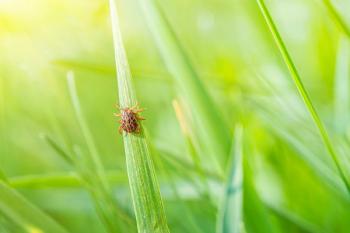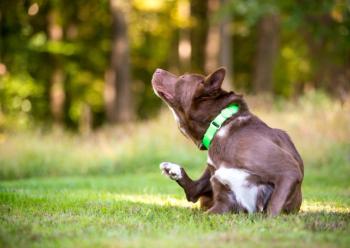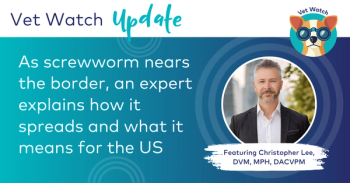
Canine and feline lungworms (Proceedings)
Metastrongyloid nematodes are characterized by having life cycles that typically require an intermediated molluscan host for the development of the third-stage larvæ that are infective to vertebrates; however, two of the species in the dog are unusual in having direct life cycles.
Metastrongyloid nematodes are characterized by having life cycles that typically require an intermediated molluscan host for the development of the third-stage larvae that are infective to vertebrates; however, two of the species in the dog are unusual in having direct life cycles. The majority of metastrongyles are associated with lung tissue, although the adults are often living within associated blood vessels. There are three lungworms that are found in dogs with some regularity in the United States, Crenosoma vulpis, Filaroides hirthi, and Oslerus osleri. In the Canada, Angiostrongylus vasorum, the "French Heartworm," has appeared in the eastern provinces in recent years. In the coastal United States around New Orleans, Angiostrongylus cantonensis, has appeared in the rodent population, and dogs are now susceptible to severe meningitis from the migratory behavior of these larvae in the canine host. Cats have been the reported hosts of four metastrongyles: Aelurostrongylus abstrusus is rather common; the other three species, Troglostrongylus subcrenatus, Oslerus rostratus, and Gurltia paralysans have only rarely been reported from cats and probably represent species typically parasitic in wild felids or other non-domestic mammals. Cats are likely to acquire their infections with these worms through the ingestion of paratenic hosts, e.g., small birds or rodents, rather than through the ingestion of the snail intermediate hosts.
Canine lungworms
Filaroides hirthi
These very small metastrongyloid nematodes are deeply buried in the parenchyma of the lungs. The worms are almost impossible to separate from the tissue at necropsy. The stage passed in the feces is a first-stage larva. Zinc-sulfate was found to be 100 times more efficient than the Baermann apparatus in the recovery of the larvae from feces. This parasite has been recognized as a parasite of colony Beagle dogs, and it continues to remain a significant pathogen in such situations.
The life cycle of Filaroides hirthi has been shown to be direct. Dogs are probably commonly infected as puppies while nursing. After larvae are ingested, they make there way to the lungs through the hepatic-portal or mesenteric lymph system. After reaching the lungs, there are four molts, and adults are mature within nine days. After five weeks, larvae appear in the feces. Larvae can persist within the mesenteric lymph nodes for extended periods and serve as a source of autoinfection. Hyperinfection has occurred in exogenously immunosuppressed animals or in animals with endogenous immunosuppression caused by hyperadrenocorticism. A case of massive infection was diagnosed at necropsy in a dog that had been receiving corticosteroid therapy for arthritis.
A light infection with Filaroides hirthi produces a nonproductive cough. As the severity disease increases, signs will include dyspnea and exercise intolerance. Lungs changes vary from small foci of granulomatous reaction to tumor-like lesions, and thoracic radiographs will show diffuse interstitial lump opacities and mixed alveolar patterns with consolidation. Treatment has usually been with the administration of fenbendazole at 50 mg per kg and prednisolone at 1.25 mg per kg for 14 days.
Oslerus (=Filaroides) osleri
This parasite causes nodules in the trachea and bronchi of dogs and other canids. These very small worms are found in nodules that tend to be located close to the bifurcation of the trachea. The stage in the feces is a first-stage larva that is hard to distinguish from the first-stage larva of Filaroides hirthi and is also best found in fecal samples by using direct smears or zinc-sulfate centrifugal flotations. The larva in feces has a tail with a constriction just anterior to its tip that causes the very tip to have a kinked appearance. Diagnosis of infection is often confirmed by the viewing of nodules in the trachea with a bronchoscope, and the presence of the fibrous nodular projections into the lumen of the trachea and bronchi is diagnostic. The life cycle of Oslerus osleri is direct. Dogs are probably commonly infected as puppies by the transmission of larvae in sputum by the licking and cleaning of the mother or through regurgitated food. The 6-7 month prepatent period is much longer than that of Filaroides hirthi.
The signs of infection are a dry cough precipitated by exercise. Laryngeal or tracheal massage does not tend to elicit a cough as in typical cases of bronchitis. Usually, no serious disease develops until the nodules begin to obstruct air flow. Some dogs present coughs that have persisted for a year or more. An atypical presentation was recurrent pneumothorax that was cured by the removal of the obstructing nodules. Nodules can be observed on radiographs, and then their presence confirmed by endotracheal observation. Treatment has been with fenbendazole (50 mg/kg daily for 7 days) and ivermectin (200 to 400 µg/kg for several weekly treatments); in some cases doramectin has also been used. The nodules can be physically removed.
Crenosoma vulpis
This is a parasite of bronchi of dogs and other canids throughout North America. The 4 to 16 mm long, white, worms have a crenated cuticle that is thrown into folds on the anterior end making this portion of the worm appearing superficially segmented. The females lay eggs that develop and hatch within the respiratory tract, and the larvae are coughed up, swallowed, and passed in the feces. Diagnosis is made by recovery of the larvae that have a very pointed tail from the feces. Larvae and adults are sometimes found in tracheobronchial mucus or bronchoalveolar lavage samples. The life cycle involves snails and slugs as intermediate hosts, and it is believed that paratenic hosts are not utilized in the life cycle.
Infection produces a dry, nonproductive cough that can be elicited by tracheal palpation. The cough in some cases may be chronic and productive. Radiographic changes include enhanced definition in the hilus and shoulder regions of the bronchial walls; marked bronchial patterns with prominent interstitial markings, and in cases where the cough is productive, cardiomegaly with interstitial patterns and tissue densities in the diaphragmatic lobe. Bronchoscopy may reveal or inflammation and moderate mucoid to mucopurulent discharge in the airways. The worms may be present in large numbers.
Treatment of Crenosoma vulpis infections have been cleared in a number of dogs with milbemycin oxime give at the heartworm preventive dosage (0.5 mg/kg one time). Also used have been fenbendazole (50 mg/kg once a day for three days and 20 mg/kg daily for 14 days) and the European formulation of Drontal Plus Flavour Tabs (50 mg praziquantel, 144 mg pyrantel embonate, and 150 mg febantel/kg once daily for 7 days).
Angiostrongylus vasorum
These 14 to 25 mm long worms live in the pulmonary arteries of the dog and other canids. Infections are most commonly seen in dogs in southern Europe, but it has appeared recently in the eastern provinces of Canada. The females lay eggs that lodge, develop, and hatch in the pulmonary arteries. The hatched larvae penetrate the alveoli and make their way to the feces via swallowing after being brought to the pharynx by coughing. The larvae in the feces have a recognizable kink to the tip of the tail and are very active when recovered with a Baermann apparatus. The life cycle involves a required snail or slug intermediate host, and frogs and rodents can serve as paratenic hosts. The worms live a long time, perhaps as long as the dog.
Dogs with long-standing angiostrongylosis present with clinical signs of gradually progressing pulmonary disease and cardiac failure. Signs can include depression, stunted growth, weight loss, decreased activity tolerance, coughing, dyspnea, and perhaps edema. On some occasions, chronic infections have been associated with coagulopathies.
Treatment of this infection is now being performed with milbemycin oxime (0.5 mg/kg once a week for 4 weeks) or with Advantage Multi (dose of 0.1 ml/kg of imidacloprid 10%/moxidectin 2.5% spot-on solution given once). Neither treatment is considered to be greater than 90% efficacious, so, it is necessary to verify that the animal is cleared and to retreat if necessary.
Angiostrongylus cantonensis
This is a parasite of the lungs of rats, but to get to the lungs, the larvae make a migration through the brain after the rat eats the snail host. The problem is that in other hosts, people and other primates, dogs, miniature horses, etc., the same thing happens with sequelae that can be life threatening. In Australia where the disease commonly affects dogs, it is often fatal. In the reported canine cases, treatment with either levamisole and mebendazole was shown to be contraindicated.
Angiostrongylus cantonensis appeared in the United States in the late 1980s in rats collected in New Orleans. Since that time cases have occurred in other animals in Louisiana and Florida. Due to the number of cases that have occurred in dogs in Australia, it seems that sooner or later clinical cases will appear in dogs within the southern United States.
Feline lungworms
Aelurostrongylus abstrusus
The adults live in the terminal respiratory bronchioles and alveolar ducts. The adult females are 9-10 mm long; the males are smaller, 4-6 mm long, and have a small bursa and relative short and stout spicules. The have a dark brown to black appearance when freshly collected. Due to the small worms being deeply within the terminal respiratory bronchioles and alveolar ducts, it is difficult to remove entire worms by dissection. The females lay eggs that contain a single cell when laid anw which embryonate within the alveolar ducts and the surround alveoli. The larvae hatch from the eggs, are carried up the ciliary escalator, swallowed, and passed in the feces. The larvae of Aelurostronbylus abstrusus are quite active larvae which are easy to recover in the feces using a Baermann apparatus. The larva is approximately 360-390 µm long and has a characteristic dorsal spine on the tail.
The life cycle of Aelurostrongylus abstrusus has been shown to involve a required snail intermediate host. It has also been shown that frogs, toads, snakes, lizards, ducklings, chickens, mice, and sparrows can serve as paratenic hosts. After the cat ingests an infective larva, probably in a paratenic host, the females begin to lay eggs as early as 25 days postinfection. The larvae first appear in the feces in 39 days.
Aelurostrongylus abstrusus can cause severe pulmonary disease with heavy infections. Cats infected with 100 larvae developed early radiographic changes 2 weeks after infection. Severe alveolar disease occurs 5 to 15 weeks after infection. Cats followed for up to a year after infection developed neither pulmonary hypertension or associated right ventricular disease. Pulmonary arteries in experimentally infected kittens show disruption of the vascular endothelium and proliferation of the endothelial cells, and as early as 10 days after infection, there is disruption of the internal elastic lamina. Hypertrophy and hyperplasia of the medial and intimal walls of the pulmonary vessels causes complete occlusion of many smaller vessels by 24 weeks after infection. Mild infections present with only minimal signs; heavy infections are associated with severe bronchopneumonia. Heavily infected cats will have rapid, open-mouthed abdominal breathing. There is a single published report of a cat dying of its lungworm infection, a 6-month-old cat that developed signs of respiratory disease when three-months-old. During the three months of illness, the cat had been observed to be coughing and sneezing with a muco-purulent discharge, and finally, the cat became dyspneic, anorexic, emaciated, and with hydrothorax.
Cats infected with Aelurostrongylus abstrusus can be treated with fenbendazole (55 mg/kg daily for 21 days or 20 mg/ kg daily for 5 days followed by a second 5 day treatment after a five day hiatus). Fifteen experimentally infected cats that were treated with fenbendazole for 3 days (50 mg/kg, once daily for three days) stopped the shedding of larvae in the feces by 14 days after treatment, but a few days later, the larvae reappeared in small numbers in the feces of the infected cats. Results with ivermecitin have been variable, however, treatment with ivermectin (200 µg/kg followed by a second treatment with 400 µg/kg) has been reported to clear a cat of its infection.
Troglostrongylus subcrenatus
Troglostrongylus subcrenatus is a nematode parasite of the lungs of felids that is related to Aleurostrongylus abstrusus and which was originally reported from a leopard in the Congo. This nematode has ben reported on a single occasion from a cat in Africa, Blantyre, Nyasaland. The adults are about twice the length of the adults of Aelurostrongylus abstrusus.
Oslerus rostratus
Oslerus rostratus is a parasite of wild felines that occasionally finds its way into bronchial submucosa of the domestic cat. Oslerus rostratus is a large worm that is closely related to the canine parasite Oslerus osleri. Oslerus rostratus has been reported from cats in the United States, Pacific Islands, Southern Europe,and the Middle East. These worms are much larger than Aelurostrongylus abstrusus: the adults of Oslerus rostratus males are 28-37 mm long and the adult females are 48-64 mm long. The larvae found in the feces are 335 to 412 µm long and have a tail that is similar to that of Oslerus osleri. The life cycle involves development in slugs with mice and birds as paratenic hosts.
Gurltia paralysans
Gurltia paralysans has been described as the cause of several cases of paraparesis in cats as the worms migrate through the nervous tissue. It is believed that the natural host of this worm is the small wild cat, Felis guigna. In 1993, a cat was presented to the clinic at Cornell that ultimately died with serious neurologic signs following progressive hind limb weakness leading to toal fecal and urinary incontinence. At necropsy, a lesion was seen in the spinal cord with extensive hemorrhage between L3 and L6. The lesion contained a worm consistent with Gurltia paralysans. Unfortunately, the lack of a male in the material teased from the lesion made it impossible to verify the identity of these worms.
Newsletter
From exam room tips to practice management insights, get trusted veterinary news delivered straight to your inbox—subscribe to dvm360.






